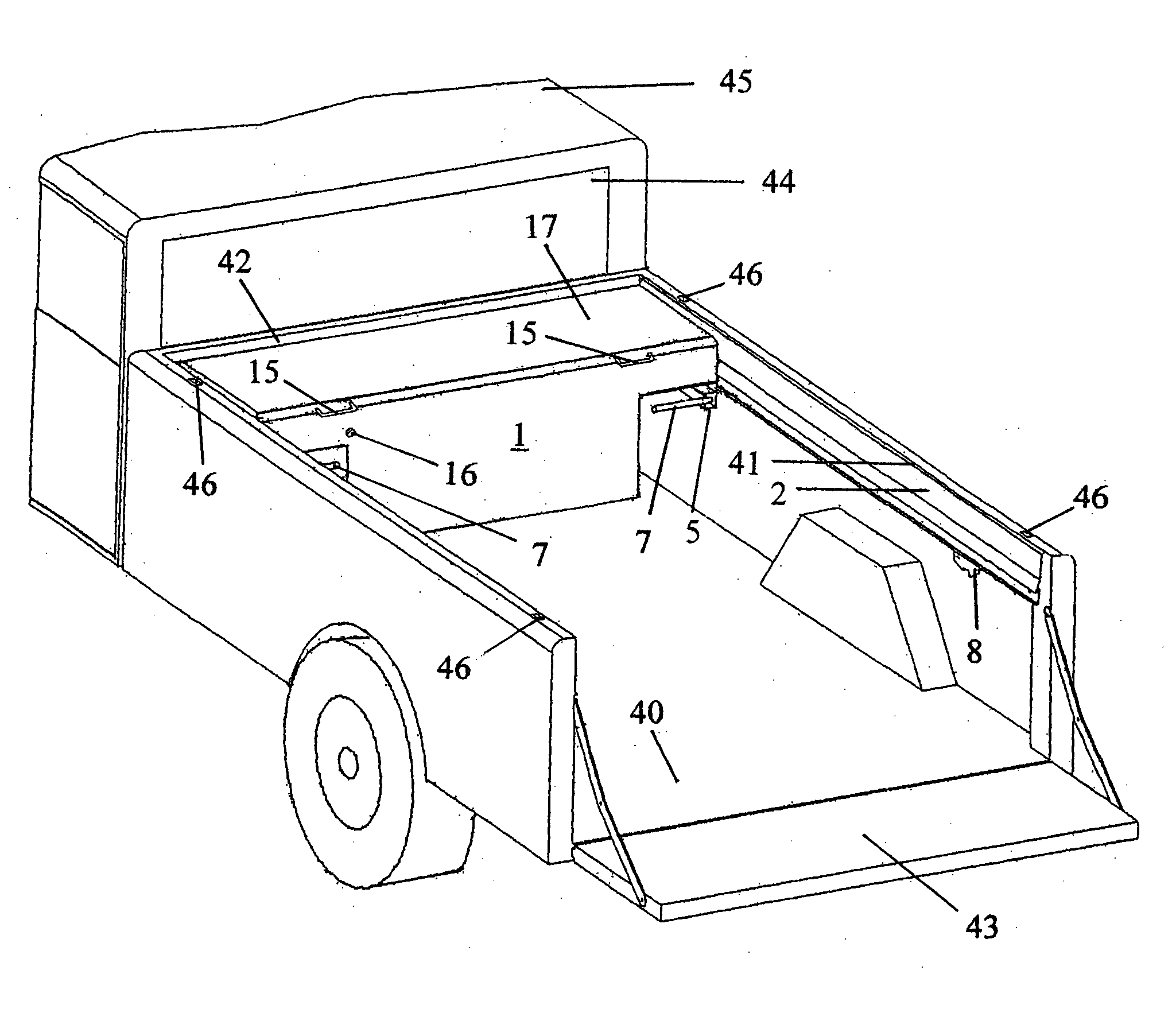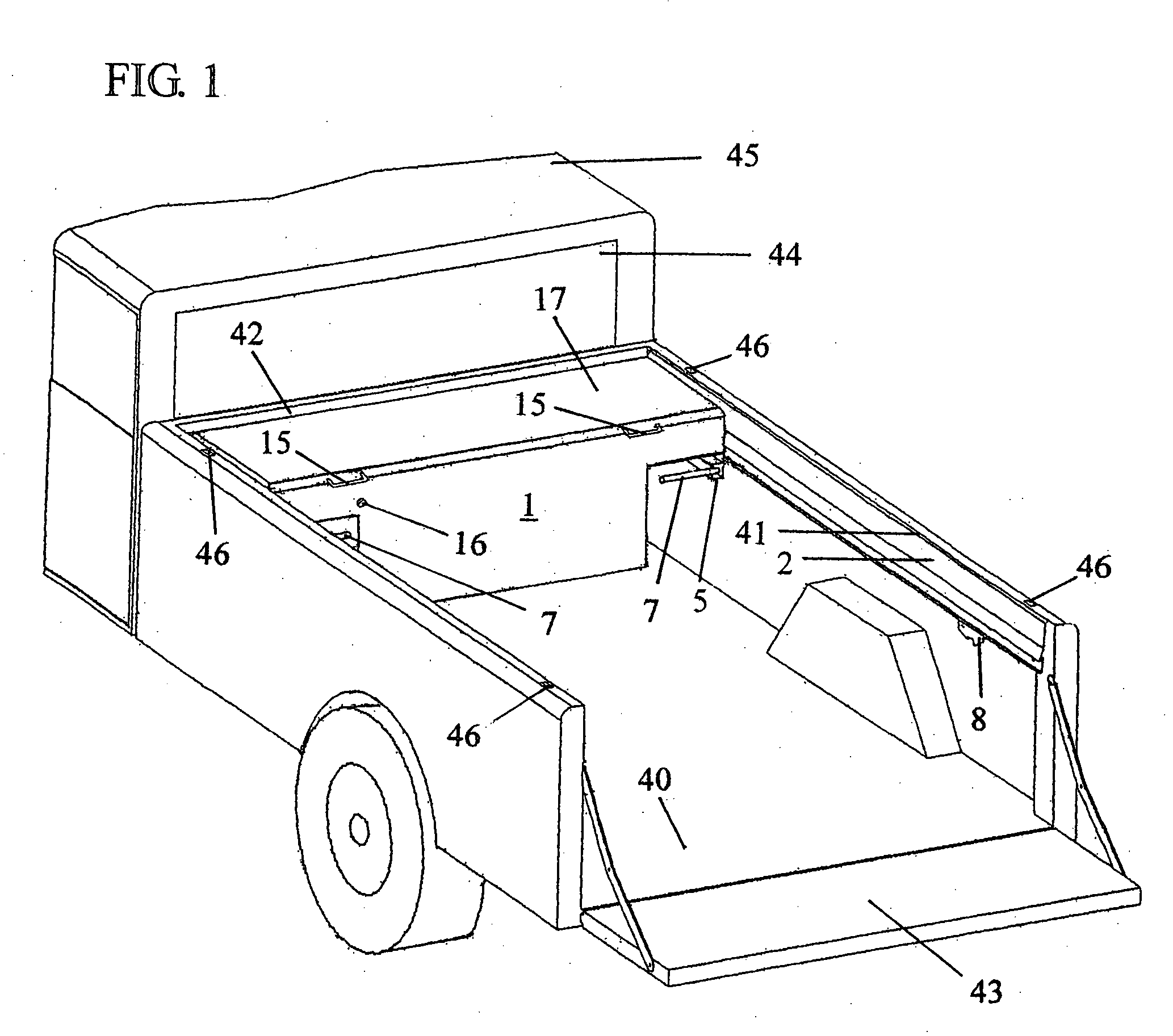However, storage containers that are placed on the floor of the cargo area create several problems since: (a) the storage container can damage the painted surface of the cargo area when dragged along the surface of the floor; (b) the storage container can damage the interior surface of the cargo area and tailgate if not properly secured and allowed to move about during the operation of the
pickup truck; (c) access to the storage container is restricted by the cargo area sidewalls and can require the user to
climb on to the
pick up truck to either place items into the storage container or to retrieve its contents.
Similarly, storage containers mounted atop the truck box sidewalls create several problems since: (a) the storage container can
restrict access to tie downs located within the truck cargo area; (b) the storage container obstructs the top of the sidewall and may also cover the stake sockets in the top of the cargo area sidewalls restricting the use of tie downs, and the installation of stake
bed type cab over storage racks, stake
bed siding, camper shells or cargo area cover; (c) the storage container can obscure the drivers view out of the rear window of the pickup trucks cab.
This device however has several problems since: (a) the cargo area floor must be clear of materials before the storage box can be rolled on or off of the
pickup truck; (b) a full storage box may be too cumbersome for one person to safely remove or place on to the truck.
This may require the user to remove some or all of its contents to make its lifting and transport more manageable; (c) a full storage box could be difficult to maneuver within the cargo area of the
pickup truck, and if not substantially parallel to the sidewalls when being rolled, it may become jammed between the sides of the storage box and the channel pieces.
However, this device also has several problems since: (a) the floor of the truck cargo area must be clear of materials before the toolbox can be rolled on or off of the pickup truck.
Having to unload the pickup truck before removing the toolbox can be
time consuming; (b) a full toolbox may be too cumbersome for one person to safely remove or install.
However, since the storage receptacle cannot be slid to the forward end of the cargo area the operator would be required to: (a) load and unload
bulk cargo up and over the storage receptacle, or from the side of the truck; (b)
climb on to the truck to load and unload
bulk cargo; (c) remove the storage receptacle from the truck to load or unload
bulk cargo.
Further, the storage receptacle may be too cumbersome for one person to safely remove or install and having to remove or reinstall the device can be
time consuming.
However, since these devices use rails or channels mounted on top of the sidewalls to convey the tool box, the operator: (a) doesn't have access to the stake sockets to secure bulk cargo; (b) would have to remove the toolbox and rails from the truck if the installation and use of a stake
bed type cab over storage rack, stake bed siding, a camper shell or cargo area cover was desired.
Also, these devices
restrict the drivers
visibility through the rear window of the pick up trucks cab.
These devices however also create several problems for the operator.
The Tijerina device was the most complex of these devices.
The costs to market, install and maintain such a device are considered prohibitive.
Also, since the tool box extends over the top of the truck cargo area sidewalls it: (a) restricts operator access to, and use of, the stake sockets in the top of the sidewalls; (b) would require removal of the toolbox if the installation of a stake bed type cab over storage rack, stake bed siding, a camper shell or cargo area cover was desired.
However, improvements to each of these devices are needed since: (a) the top of each of these storage containers extends above the top of the cargo area sidewalls restricting the use of various after market cargo covers without altering or removing the tool box; (b) there is no locking device to secure the tool box top lid to prevent pilfering; (c) the toolbox of the Tuohy device obscures the drivers view out of the rear window of the pickup trucks cab.
A single rod however may bend and become jammed in the aperture or may prove to be insufficient to restrain a heavily loaded toolbox during operation of the pickup truck.
Also, alignment of the apertures in the rails or channels could be
time consuming during installation and difficult to maintain in operation.
If the pole of the Tuohy device, previously discussed, becomes jammed between the toolbox and channel the operator would not be able to move the toolbox when desired.
An additional problem for the Barahas and Hamilton devices is the location of their latch release levers.
This may require the operator to stand in traffic to release the storage container from its latched position or
climb on to the truck if unable to reach the
handle from the passenger side of the truck.
This may require the operator to climb on to the truck to release the storage container from its latched position if the latch release
handle isn't easily reached from either side of the truck.
 Login to View More
Login to View More  Login to View More
Login to View More 


